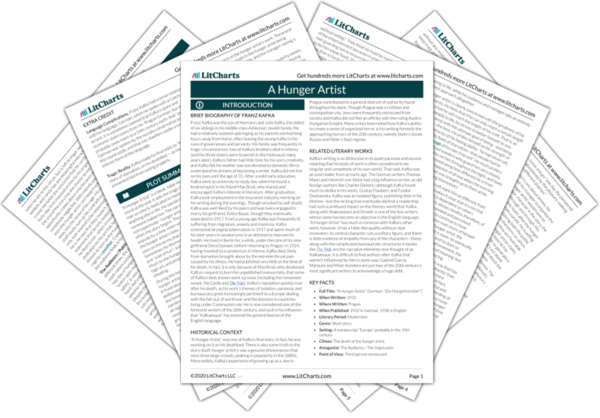There isn’t a single instance of the hunger artist leaving his cage in the story. Both symbolically and literally, the cage serves to completely separate the hunger artist from the rest of society, allowing him to focus entirely on practicing his “art.” The cage demonstrates his rejection of all other pursuits: his art is on the inside, and all other worldly (and to him, unworthy) concerns remain on the outside. This purity of separation is only violated when others, like the manager, cross the threshold and prevent the hunger artist from taking his starvation as far as he would like. In this sense, then, the cage is the tool that liberates the artist from the rest of the world. In the same way that mankind uses cages to separate itself from animals, the artist uses the cage to distinguish himself from the petty concerns of everyday life. Of course, this is extremely paradoxical—the whole point of cages is that they imprison their contents, restricting movement and possibilities of escape. The cage, then, is also the hunger artist’s entrapment—he is trapped by his own ideals, the audience’s perceptions of him as mere entertainment, the manager’s economic interests and, later, by his own irrelevance. More widely, the cage stands as a symbol of the separation between artist and audience; specifically, between artists’ intentions and audience responses. Kafka’s use of the cage suggests that no matter how hard an artist tries, they can never control how their work is received: society will decide what that artist’s work means, and from those perceptions construct the cage that ultimately defines the artist’s life. The story is neither sympathetic to nor critical of this idea, but instead shows it in its full complexity. The hunger artist thinks he’s free, but willingly keeps himself in the cage, and can never truly know what it is like to perceive his work from the other side of the bars.
The Cage Quotes in A Hunger Artist
…scorning the use of a chair he sat on the scattered straw, pale, in a black vest, with startlingly protruding ribs, now nodding politely, answering questions with a strained smile, or poking his arm through the bars so that its thinness might be felt, but repeatedly collapsing into himself, not caring about anything or anyone.

Unlock explanations and citation info for this and every other A Hunger Artist quote.
Plus so much more...
Get LitCharts A+He much preferred those invigilators who sat right in front of his bars, who were not content with the dim night-light in the hall, but aimed at him the beams of electric torches that the manager had left at their disposal…What made him happiest of all was when the morning came and a lavish breakfast was brought up to them at his expense, on which they flung themselves with the healthy appetite of men who had spent an entire night without rest.
He had never yet—that people had to concede—left his cage of his own free will. The maximum period of starvation had been set by the manager at forty days, he permitted no longer stints than that, not even in major cities, and for a very good reason. He had learned from experience that by gradually intensified publicity the interest of a city could be kept alive for forty days, but at that point the public failed, there was a perceptible drop in the level of interest.
So then on the fortieth day the door of the flower-garlanded cage was thrown open, an excited audience filled the amphitheatre, a brass band played, two doctors entered the cage to perform the necessary tests on the hunger artist, the results were relayed to the hall by means of a megaphone, and finally two young ladies, thrilled to have been chosen for the task, came to lead the hunger artist down a couple of steps to where a small table had been laid with a carefully assembled invalid meal.












